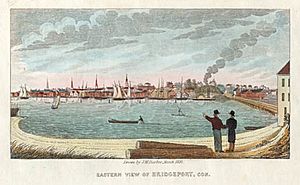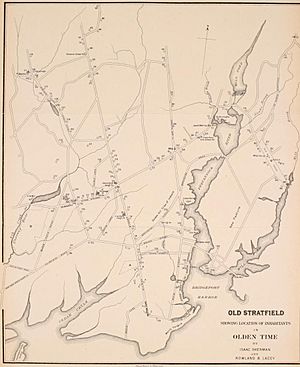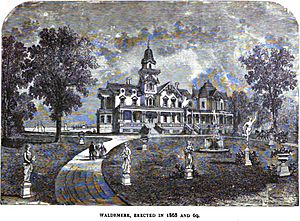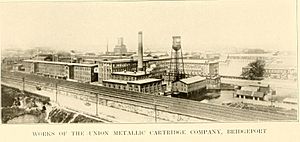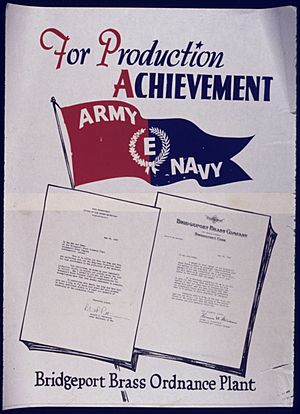History of Bridgeport, Connecticut facts for kids
The history of Bridgeport, Connecticut tells the story of a city that grew from a small farming and fishing village into a busy industrial center. For many years, it was a hub for shipbuilding and whaling. Later, with the arrival of the railroad and many factories, Bridgeport became a major city where lots of people came to live and work. At its busiest in 1950, about 159,000 people lived here, making it Connecticut's second largest city. In more recent times, many factories closed, and the city's population changed, but it still became the most populated city in Connecticut by 1980.
Contents
Early Days
Long before European settlers arrived, the land that is now Bridgeport was home to the Pequonnock Indians, part of the Paugussett nation. Their village had about 500 to 600 people living in around 150 homes.
Colonial Times
The first English settlers came to the west side of the Pequonnock River around 1665. They called their settlement Pequonnock. Later, it was renamed Newfield. More people moved inland, and the whole area became known as Fairfield Village in 1694. This name officially changed to Stratfield in 1701 because it was located between the towns of Stratford and Fairfield. People in Stratfield started a school in 1678 and built a church in 1695.
Growth and Change (1700s-1800s)
During the American Revolution, Bridgeport was a place where privateers (ships allowed to attack enemy vessels) operated. Captain David Hawley brought many captured ships into Black Rock Harbor.
In 1800, Newfield village became the borough of Bridgeport. In 1821, the larger area, including parts of Stratfield, became the township of Bridgeport. Finally, Bridgeport officially became a city in 1836.
At first, Bridgeport relied on fishing and farming. But its location on the deep Newfield harbor helped it become a big center for shipbuilding and whaling in the mid-1800s. To help ships navigate, the Bridgeport Harbor Light was built in 1851.
The city grew even faster after the railroad arrived. Bridgeport was connected by train to New Milford in 1840, then to Waterbury and New Haven in 1848, and to New York City in 1849.
Around the 1820s, when Connecticut ended slavery, free African Americans began to settle in a neighborhood called "Little Liberia." Some of the oldest houses there date back to 1848. By 1840, about 148 "colored persons" lived in Bridgeport.
East Bridgeport was mostly farmland in the 1830s. But new bridges over the Pequonnock River in the 1840s and 1850s helped this area grow into a major industrial zone.
Abraham Lincoln's Visit
In February 1860, Abraham Lincoln traveled east to give a speech in New York City. He impressed many people and gained support for his presidential campaign. He then gave several similar speeches in Connecticut and Rhode Island. His last speech was in Bridgeport on March 10.
Lincoln arrived by train and likely met with local leaders. He stayed at the home of Frederick Wood. Some stories say he tried New England fried oysters there for the first time!
He spoke in Washington Hall, which was then Bridgeport City Hall. The room was packed, and many people stood outside because they couldn't get in. He received a standing ovation. A plaque now marks the spot where he gave his speech.
P.T. Barnum, Showman and Mayor
Bridgeport's most famous resident was P.T. Barnum, the famous circus promoter. He built four houses in the city and kept his circus there during the winters. The Barnum Museum in Bridgeport has many items related to Barnum and the city's history. Since 1949, Bridgeport has held an annual Barnum Day parade, which has grown into a multi-day festival. Barnum is buried in Mountain Grove Cemetery, Bridgeport, a park-like place he helped design.
More Parks for Everyone
Washington Park in East Bridgeport was first set aside as a park in 1851 by William H. Noble and P. T. Barnum. As the city grew, people realized they needed more green spaces. In 1864, Barnum and others donated land to create Seaside Park, which grew to about 100 acres by 1884.
In 1878, James W. Beardsley, a wealthy farmer, gave over 100 acres of land to the city to be used as a public park forever. In 1881, the city hired Frederick Law Olmsted, who designed New York City's Central Park, to create a plan for Beardsley Park. Olmsted described the land as "pastoral, sylvan and idyllic," meaning it was like a peaceful, wooded countryside. He designed a simple, rural park for people to enjoy nature.
Bridgeport's parks weren't just for picnics. Newfield Park was home to the Bridgeport Orators, a minor league baseball team that won a championship in 1904. Over time, more parks and attractions were added, including Beechwood Park, a zoo in Beardsley Park, and Pleasure Beach, which had a popular amusement park for many years.
Late 1800s
Bridgeport took over Black Rock and its busy harbor in 1870. This added the Black Rock Harbor Light and later the Penfield Reef Light to help ships navigate. The Tongue Point Light was built in 1895 to mark the west side of Bridgeport harbor.
In the late 1800s, Bridgeport became the main city (county seat) for Fairfield County. Even though county government ended in Connecticut in 1960, the Fairfield County Courthouse built in 1888 still stands today.
Early 1900s
In 1902, a new railroad bridge, the Pequonnock River Railroad Bridge, made train travel easier. Trolley service also came to Bridgeport, and a large repair facility, the Connecticut Railway and Lighting Company Car Barn, was built in 1910.
Factories and Businesses Grow
Bridgeport quickly became a major manufacturing city in the late 1800s. Factories here made things like the famous Bridgeport milling machine, brass parts, carriages, sewing machines, saddles, and ammunition. Some companies even helped their workers beyond just paying wages. For example, the Warner Brothers Corset Company built the Seaside Institute as a social and educational center for its women employees.
The Union Metallic Cartridge Company opened an ammunition factory in Bridgeport in 1867. This factory became part of Remington UMC in 1912. When World War I started in Europe in 1914, Bridgeport became a huge center for making weapons, sometimes called "the Essen of America." The city's population grew very quickly, almost 50 percent in less than two years. Remington UMC built a massive factory complex and hired thousands of workers to fill orders, including a huge one from the Russian Empire.
By 1930, Bridgeport was a busy industrial city with over 500 factories and many immigrants. World War II gave another boost to the city's industries. Famous factories included Wheeler & Wilson (sewing machines), Remington UMC, Bridgeport Brass, General Electric Company, and the Locomobile Company of America (cars).
The city was home to the Frisbie Pie Company from 1871 to 1958, which is why some people say Bridgeport is where the frisbee was invented! Also, Bridgeport had the first dental hygiene school in the country, opened in 1913 by Dr. Alfred Fones.
Bridgeport also saw business growth. Several banks and stores like D. M. Read's department store opened downtown. In 1965, the first Subway Restaurant opened in Bridgeport.
A growing city needed more schools. New schools like Maplewood School (1893), Central High School (1876), Warren Harding High School (1924), and Bassick High School (1929) were built.
Workers Speak Up
With so many factories, workers sometimes faced tough conditions. In the summer of 1915, many strikes started in Bridgeport, demanding an eight-hour day. These strikes were very successful and spread to other cities. Thousands of workers, including many women who were not allowed in traditional unions, took part. For example, women workers at the Bryant Electric Company started a strike that led to the company agreeing to an eight-hour day, overtime pay, and union representation. These strikes changed Bridgeport into an "eight-hour day city."
After World War I and during the Great Depression, workers continued to push for better conditions. This led to Jasper McLevy, a socialist leader, becoming mayor of Bridgeport from 1933 to 1957.
New People Arrive
Bridgeport's factory growth attracted many immigrants from other countries. By 1920, over 32% of the population was born outside the U.S., and another 40% were children of immigrants. Most immigrants lived near the factories and the shore, including people from Eastern and Southern Europe, Scandinavia, and Ireland. At this time, African Americans made up about 1.6% of Bridgeport's population.
The growing city needed more homes. Developers built neighborhoods like Sterling Hill for Irish working-class families, and the Bassickville Historic District with rental units from the 1880s. Emergency housing for workers during World War I became the Black Rock Gardens Historic District.
New immigrants also built their own places of worship, such as the Polish community's St. Michael's church (1907) and the Hungarian Jewish community's Achavath Achim Synagogue (1926). Bridgeport had a large Hungarian American community, and many worked in factories. They even had their own newspaper called Előre ("Forward").
Later Years (Late 1900s)
Like many cities in Connecticut, Bridgeport faced challenges in the 1970s and 1980s as many factories closed down. People also moved to the suburbs, and some city officials were found to have mismanaged things.
The building of Interstate 95 in the 1950s caused many homes to be torn down, including a large Hungarian neighborhood.
From the mid-1960s to the early 1990s, Bridgeport faced issues with safety. Many people moved out of the city, and the population dropped from 158,709 in 1950 to 141,686 in 1990.
Bridgeport also had problems with economic inequality. While the city's downtown remained desirable for businesses, some neighborhoods, especially public housing areas, became very run-down and had many problems. For example, Father Panik Village, which opened in 1939 as the first public housing project in New England, faced serious neglect by the late 1970s. It had many problems, and the city eventually started tearing it down in 1986, with the last buildings gone by 1993.
The city also experienced problems with fires during this time, even as the Bridgeport Fire Department faced cuts. Many large manufacturing companies moved out of Bridgeport.
Martin Luther King Jr. spoke in Bridgeport several times in the 1960s, at the Klein Auditorium and Central High School.
In 1987, a building under construction called L'Ambiance Plaza collapsed, tragically killing 28 construction workers. This was a major disaster for the city, and emergency crews from all over New England came to help.
In 1991, the city tried to file for bankruptcy protection, but a federal court decided it was financially stable.
Bridgeport Today (21st Century)
Bridgeport's population has grown in the 21st century, though it still faces challenges like poverty and crime.
Many big projects have been planned and completed downtown. In 2021, the city opened the Hartford HealthCare Amphitheater, a large outdoor venue for concerts. There are also plans for new developments in the Steel Point area, including ideas for a casino, though these have faced challenges due to contaminated soil.
Many of Bridgeport's old historic buildings have been turned into homes. For example, in 2004, the former Read's Department Stores building became a place for artists to live and work. In 2007, an old bank headquarters was turned into apartments. The Great Recession in the late 2000s slowed down some development projects. In 2009, the City Council approved a new plan to guide development and protect neighborhoods.
In 2006, then-President George W. Bush visited Bridgeport and spoke about health care reform at the Playhouse on the Green.
Images for kids
-
Ringling Brothers Circus headquarters, about 1911


